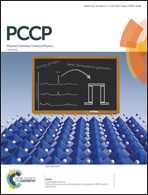A theoretical study of low-lying singlet and triplet excited states of quinazoline, quinoxaline and phthalazine: insight into triplet formation
Abstract
Quinazoline, quinoxaline and phthalazine are nitrogen containing heterocyclic aromatic molecules which belong to the class diazanaphthalenes. These isomers have low-lying nπ* and naphthalene-like ππ* states that interact via spin–orbit coupling. In this contribution, we study their structure and electronic states by means of a coupled-cluster method. The computed properties are compared to those of cinnoline which were obtained in our previous study [Etinski et al., Phys. Chem. Chem. Phys., 2014, 16, 4740]. The excited state features of these isomers are dependent on the position of the nitrogen atoms. We find that quinazoline and quinoxaline exhibit similarities in the ordering and character of the excited states. In contrast, a marked difference in the electronic and geometric structures of the lowest excited triplet states of cinnoline and phthalazine is noticed, although both are orthodiazanaphthalenes. Our findings suggest that the S1 ![[radiolysis arrow - arrow with voltage kink]](https://www.rsc.org/images/entities/char_e116.gif) T1 channel is responsible for the rapid intersystem crossing in quinazoline and quinoxaline, whereas the S1
T1 channel is responsible for the rapid intersystem crossing in quinazoline and quinoxaline, whereas the S1 ![[radiolysis arrow - arrow with voltage kink]](https://www.rsc.org/images/entities/char_e116.gif) T2 pathway is active in phthalazine.
T2 pathway is active in phthalazine.



 Please wait while we load your content...
Please wait while we load your content...